SRMAP Departmental Events
- Dr Aswini Presents a Poster on the International Stage August 23, 2023
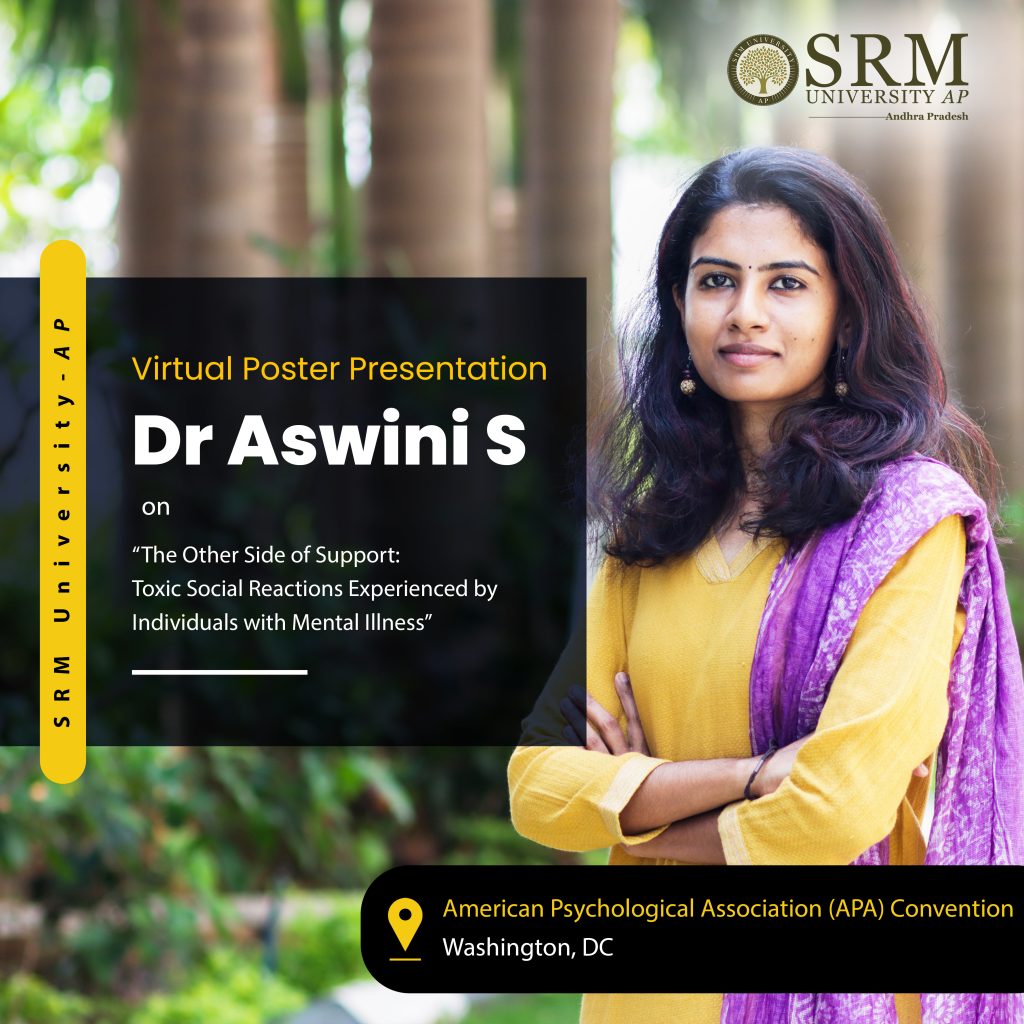 In a proud moment that highlights our institution’s commitment to excellence and innovation, we are thrilled to share the success of a recent poster presentation that graced the global stage.Dr Aswini S, Assistant Professor at the Department of Psychology at SRM University-AP recently represented the varsity at the American Psychological Association (APA) Convention in Washington, DC from August 3 – 5, 2023. The occasion was a prestigious Poster Presentation, titled, “The Other Side of Support: Toxic Social Reactions Experienced by Individuals with Mental Illness”
In a proud moment that highlights our institution’s commitment to excellence and innovation, we are thrilled to share the success of a recent poster presentation that graced the global stage.Dr Aswini S, Assistant Professor at the Department of Psychology at SRM University-AP recently represented the varsity at the American Psychological Association (APA) Convention in Washington, DC from August 3 – 5, 2023. The occasion was a prestigious Poster Presentation, titled, “The Other Side of Support: Toxic Social Reactions Experienced by Individuals with Mental Illness”Abstract
Social support is undeniably an important aspect of everyday life, and it is particularly
important in the context of challenges. The role of social support as a protective factor is well established (Wright et al., 2013) in research, especially in the context of mental illness (Frame, 1981; Teo et al., 2020). While acknowledging the overwhelming evidence on the importance of social support, there is scant literature on the negative experiences of seeking and receiving support. The qualitative investigation revealed the toxic social reactions under the disguise of social support as reported by participants with mental illness (N=17). Participants experienced interactions which sometimes resembled social support but were either harmful or not beneficial to them. The frequently reported reactions of participants are trivialising of symptoms, toxic positivity, and fake sympathy. In comparison to physical illness, the indicators of mental illness are less objectively perceptible to others. Hence, the practice of dismissing symptoms and attributing disorders as momentary feelings, or imaginary experiences are found to be common. Moreover, the suggestion to be positive and reject anything that may trigger negative emotions along with the display of fake sympathy by people around is also found in participant narratives. This signifies the importance of studying social support through different dimensions rather than just focusing only on support that is helpful and beneficial. Future explorations can focus on understanding specific sources of support, kinds of support and the impact that such challenges have on the quality of relationships with significant others.
Keywords: Toxic positivity, mental illness, social supportThe remarkable achievement underscores not only the quality of education we provide but also the dedication of our faculty in making impactful contributions to their fields.
Continue reading → - Careers in Molecular Biology and Biotechnology-srmap June 1, 2023
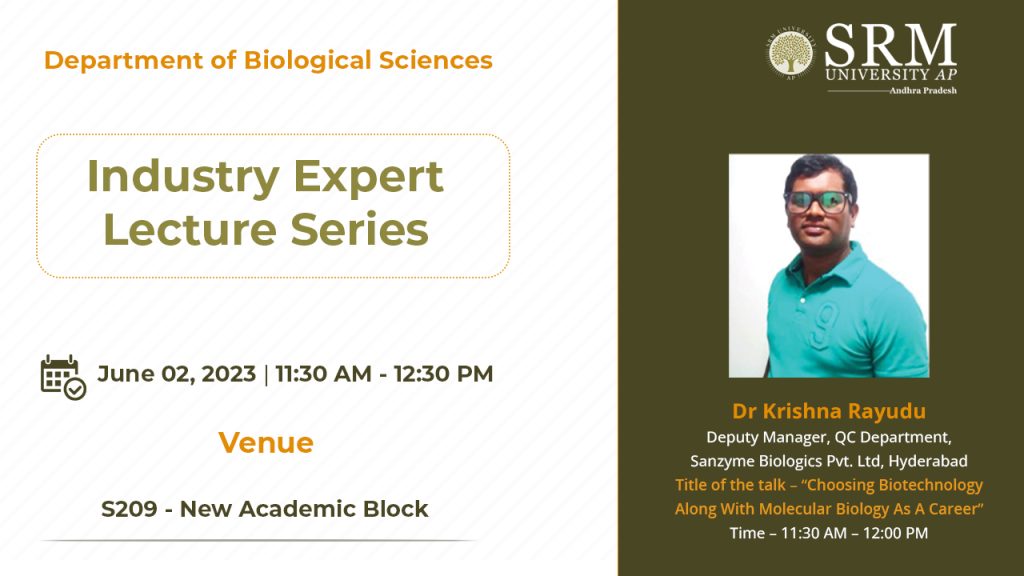
The Department of Biological Sciences is organising an Industry Expert Lecture Series featuring talks from industry experts from various domains of biology. As part of the series, a lecture titled “Choosing Biotechnology along with Molecular Biology as a Career” will be delivered by Dr Krishna Rayudu from Sanzyme Biologics Pvt. Ltd. on June 02, 2023. The talk will highlight industry expectations and skill development for BSc, MSc, and PhD students to enter into Biotech Industries.
Join the session to gain insight into the scope and opportunities for a successful career in the Biotech industry!
Continue reading → - Upskill your assets through App design January 23, 2023
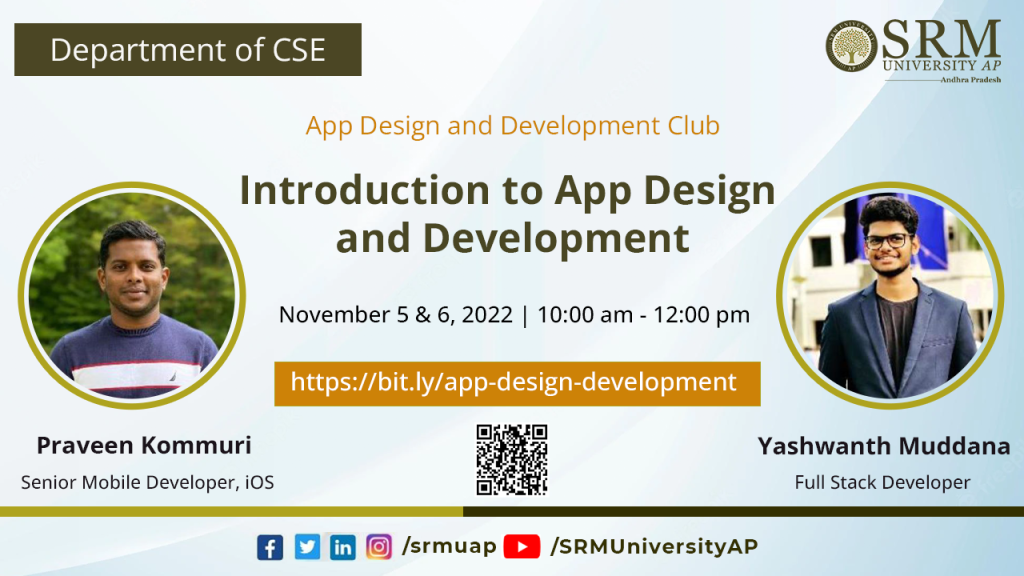
It is a prerequisite for technophiles to upskill their assets and sharpen their practical knowledge on tech operations and functions. The App Design and Development Club in association with the Department of Computer Science and Engineering is organising a workshop on the “Introduction to App Design and Development” on November 05 and 06, 2022 to help polish their tech savviness. Mr Praveen Kommuri, Senior Mobile Developer, iOS and Mr Yashwanth Muddana, Full Stack Developer will address the webinar.
About the speaker
Mr Praveen Kommuri has 11+ years of experience in iOS & amp; Mac application design and development. Currently, he is working as a Senior Mobile Developer, Senior Mobile Developer – iOS, Stanley Black & Decker, Inc., USA. Prior to this, he worked as a Senior Software Engineer at Way.com, Inc. USA from January 2017 to September 2021. Whilst in Way.com, he redesigned the Way app from scratch with brand new features. Being the lead, he has participated in UI discussions and implemented many UI and functional modules. He has taken data driven decisions based on Analytics data and implemented A/B Test on all new features. He improved app ratings from hundreds to 25k in a short time and collected valuable user feedback incorporated in the immediate releases. He worked as a consultant in Apple, Sunnyvale, California, USA where he worked on Apple’s internal iOS and Mac applications. He also served as a system analyst and system software engineer in QueST Global, Aspire Infolabs Pvt Ltd. Mr Praveen worked across multiple projects and threads. His creative thinking, expertise, and positive can-do attitude is awe inspiring. Mr Praveen’s strengths in pro-actively offering solutions and ideas, strong technical skill and being adept at all aspects of communications is an example for budding technophiles.
Mr Yashwanth Muddana is a Full Stack Developer who is passionate about solving the challenging problems with tech solutions. He has worked for many start-ups as a full-stack developer, mentored a web and app development club in the college and has done 10+ freelance projects. Mr Muddana is a React JS and React Native developer, UI/UX designer. He uses Node for the server and MySQL and MongoDB for the database. Besides that, he has experience on MEAN Stack, PHP, and many SDKS for analytics, Maps, Ads, Push Notifications and many more. He worked as a Software Developer, Zasket (Part Time) from September 2021 to May 2022. He has secured a job in Krypto Company with a CTC of 60 LPA and is also working on his own start up idea.
Join the webinar to improve your tech savvy!
Continue reading → - Blockchain Technology and its applications. September 22, 2022
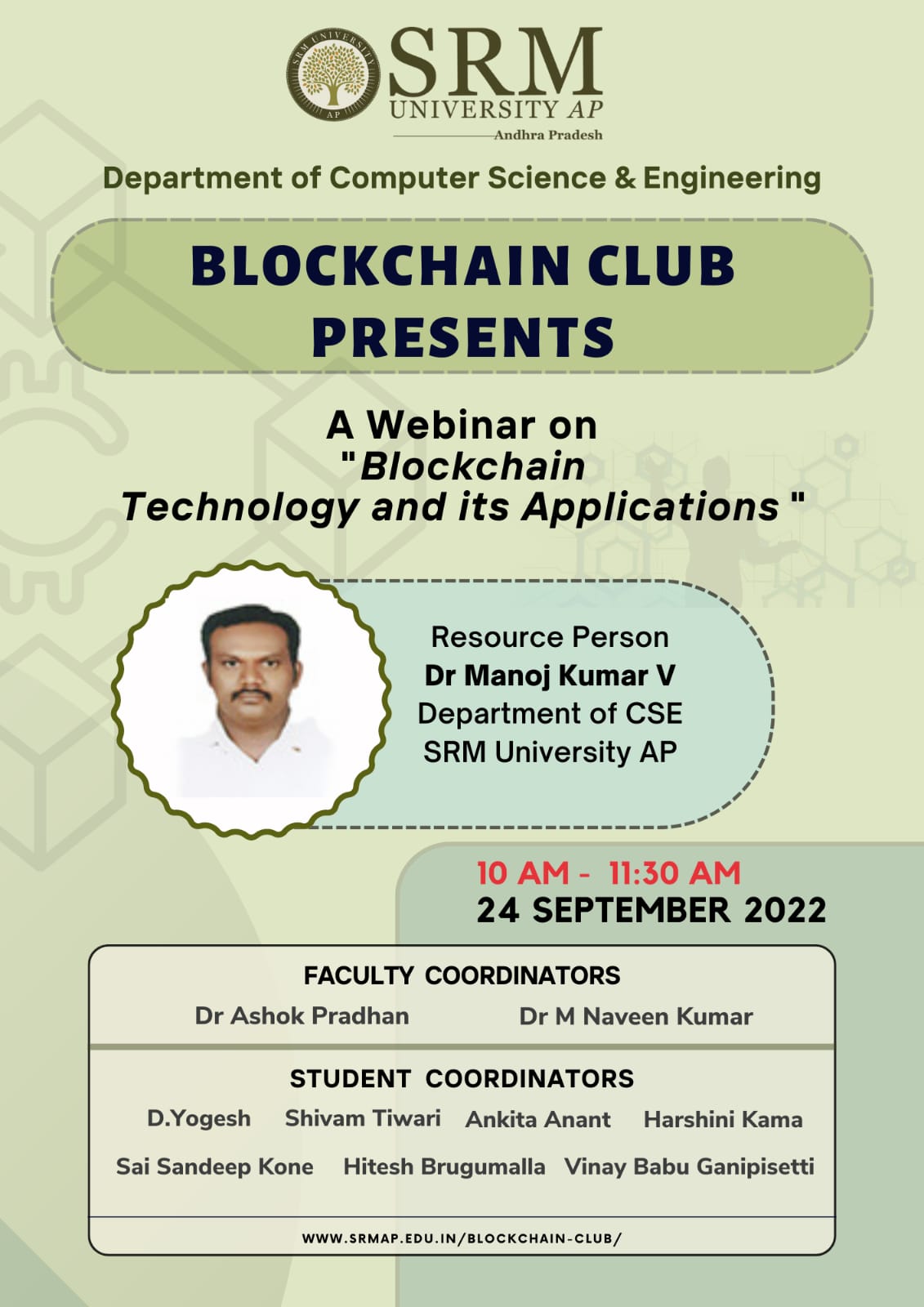 Blockchain is a digital ledger of any transactions or contracts that need to be independently recorded. This technology underpins digital currency transactions. It can be utilised in many industries, including Financial Services, Healthcare, Government, Travel and Hospitality, and many more. The Blockchain club of the Department of Computer Science and Engineering is hosting a webinar on Blockchain Technology and its applications.
Blockchain is a digital ledger of any transactions or contracts that need to be independently recorded. This technology underpins digital currency transactions. It can be utilised in many industries, including Financial Services, Healthcare, Government, Travel and Hospitality, and many more. The Blockchain club of the Department of Computer Science and Engineering is hosting a webinar on Blockchain Technology and its applications.Date: September 24, 2022
Time: 10.00 AM to 11.30 AM
Assistant Prof Dr Manoj Kumar V of the Department of Computer Science and Engineering, will handle the session. More than 130 participants will be attending the programme.
About the speaker
Dr Manoj Kumar V did his PhD from NIT Tiruchirappalli. He has teaching experience at VIT- AP university, Anjalai Ammal Mahalingam Engineering College, Tamil Nadu, and Mount Zion College of Engineering and Technology, Tamil Nadu. Internet of Things, Blockchain, and Cryptocurrency are his primary research interests.
Click here to join the webinar!
Continue reading → - Introduction to hackathon: best practices September 19, 2022
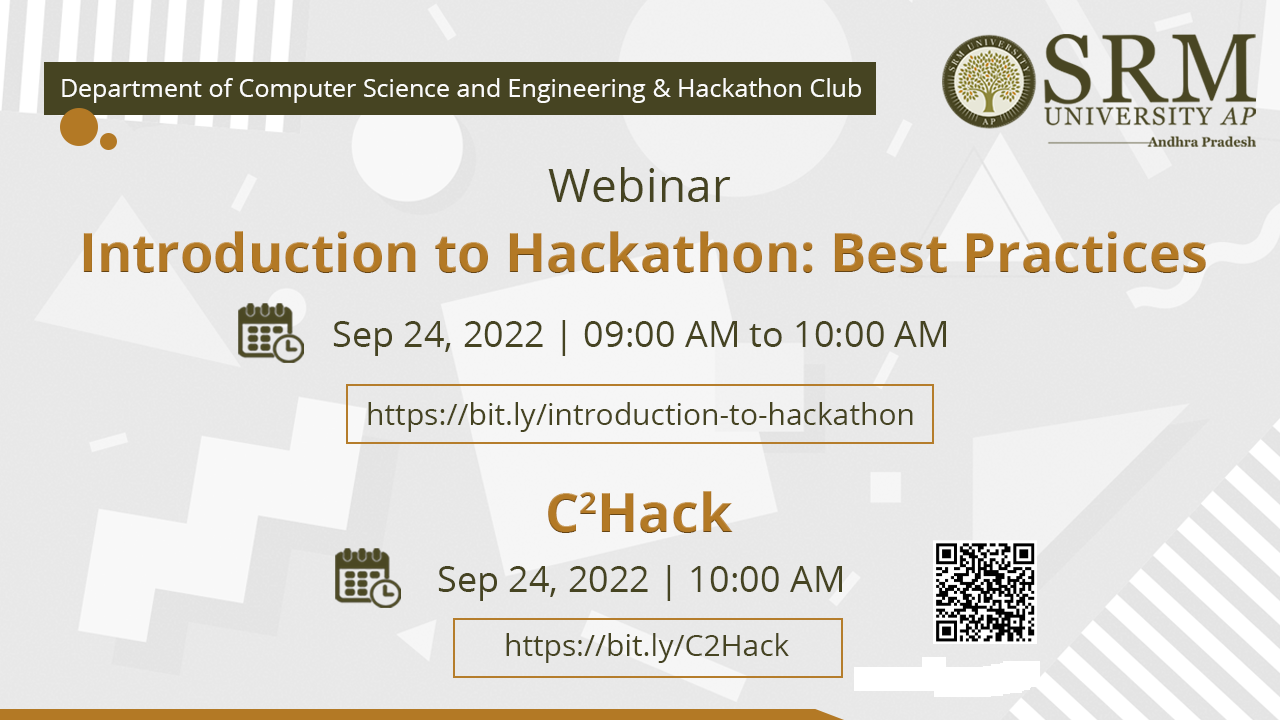
The Department of Computer Science and Engineering in association with the SRM AP Hackathon club is organising a webinar titled Introduction to Hackathon: Best Practices from 9 am to 10 am, followed by a 24-hour internal hackathon C2Hack at 10 am on September 24, 2022.
A hackathon is a social coding event bringing together computer programmers and other technology enthusiasts together to conceive a new software programme or redesign an existing programme to enhance its performance. Hackathons present a constructive platform for developing prototypes for various applications and programming languages or for providing solutions to real-life challenges ranging from educational technology to disaster management.
Hackathons are thus classified into different types based on their objectives and themes. Having a well-defined set of rules is a necessity while organising a hackathon. The webinar intends to introduce students to the fundamentals of hackathon and some of the effective practices one may follow while participating in a hackathon. Students will also be given the opportunity to test their hacking skills in an internal hackathon C2Hack following the session.
Join the webinar and learn how to use your tech genius to find solutions to the greatest of real-life challenges. Every hackathon is a smart route to actualise your ideas into innovations.
Continue reading →

